
views
Preparing to Cut

Wash your hands. It is important to wash your hands every time you are about to handle food. Also, you should wash your hands when you are switching between handling raw meat and any other type of food. Proper hand washing technique includes using antibacterial soap, lathering the soap on the palms and back of the hands as well as under finger nails and between fingers for at least 20 seconds.
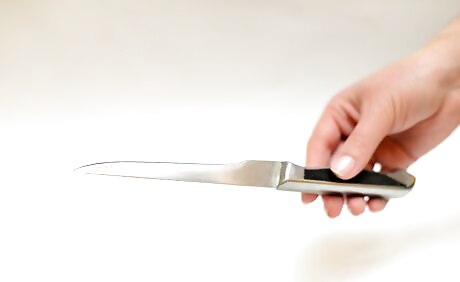
Use a boning or breaking knife to cut ribs. Specifically, use these knives that also have either a straight or granton edge. . A straight edge knife is smooth on the cutting side as opposed to a serrated edge that would have large grooves. A granton edge has a row of identical scallops on each side of the cutting edge.
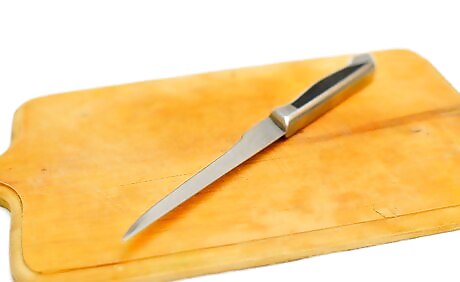
Set out a cutting board. You may choose either a wood board or non-porous material like plastic. While plastic is easier to clean, both options are safe to use for cutting raw meat.
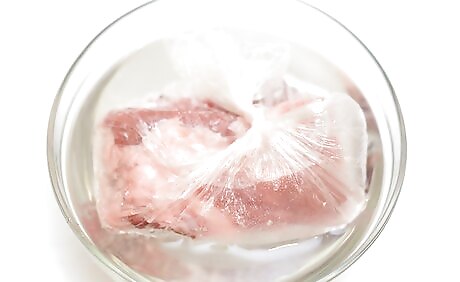
Thaw the meat in 40 °F (4 °C) for 30 minutes per 1 lb (0.45 kg). Place the ribs in a sealable plastic bag and then into a sink filled with the cold water. Stir the water occasionally to break the barrier between the cold and warm water. You can also thaw the ribs by placing them in a refrigerator. For every 4 lb (1.8 kg), it will take 1 day to thaw. Make sure to put the ribs in a pot or container that is large enough to catch drips.
Cutting Pork Spare Ribs
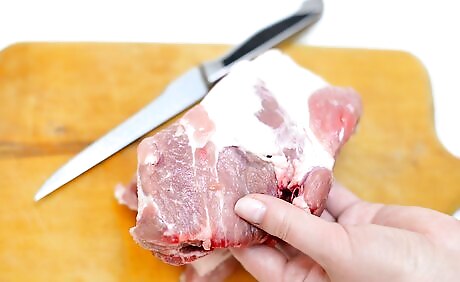
Identify the main 3 parts of the rack of ribs. The part you want to end with is the pork rib section. Other parts will need to be cut away from the ribs. The skirt is a flap of meat located on the back of the rack in the middle. The rib tips are on the bottom of the rack. The point is a large piece of meat at one far end of the ribs. The sternum, otherwise known as the breastbone, is attached to the rib cage at the wider end.

Remove the skirt. You will find this flap of meat at the narrow end of the rib cage attached to the last bone on the back of the rack. The back is the side where more bone is exposed. Make a cut parallel to the last bone, getting as close to the bone as possible. Then, cutting as close to the rib cage as possible, cut along the entire piece of meat until it is completely separated from the rack. You don't want to go so far down that you're cutting an old bone. You want to be in that range where the bone is soft, and it's gonna get in.
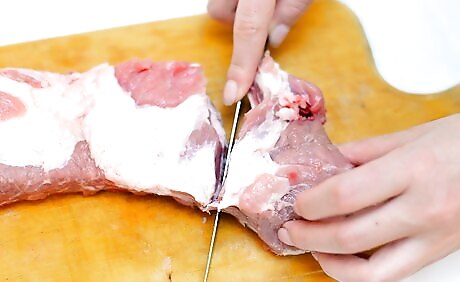
Cut away the point. The point is the triangular section next to the last rib bone. It tapers in width wide to narrow as it gets further away from the last bone. This needs to be removed in order to isolate the ribs. If this piece is left attached to the ribs, it will most likely become overcooked and affect the overall flavor of the ribs. You can save this piece of meat for another dish in the future by freezing it or keeping it in the refrigerator for no more than 5 days before cooking.

Take off the sternum. The sternum is the thickest part of the spare rib slab. Looking at the wider end of the rack, find the longest rib. Feel along the bone for a soft spot toward the bottom of the rib. Once the soft spot is found, cut through the spot perpendicular to the bone. Repeat this step for each rib until each rib’s soft spot is cut through completely. You can save this piece of meat, as well, and preserve similarly to the skirt meat. This will ensure the whole sternum, including the breast bone and cartilage is cut away.
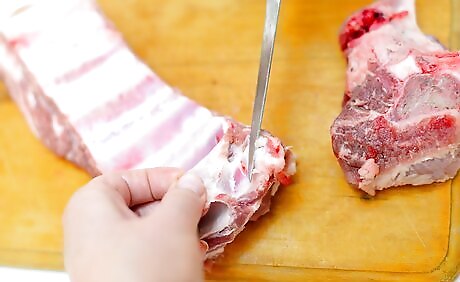
Pull off the membrane. Starting at a corner of the ribcage, use a knife to find the end of the membrane. Cut between the membrane and bone so you are able to grab a piece of the membrane. Using a paper towel or other fabric for grip, slowly pull the membrane upwards and away from the ribs. The membrane is also known as the "fell".

Use a knife to cut away extra fat. Once the membrane has been removed, pockets of fat will become exposed. Remove these pockets. Also, cut away fat from the other side of the ribs. These pockets of fat will appear white or tan in color and to be hanging off of the rib cage.
Cutting Beef Short Ribs
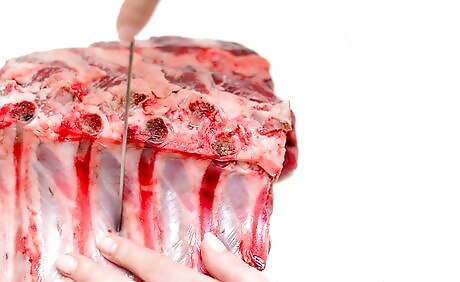
Separate the hind quarter of the rib cage from the fourth quarter. Find the space between the 12th and 13th ribs. Cut the 13th rib away from the rest of the ribcage. You can save the 13th rib for other uses such as sausage.
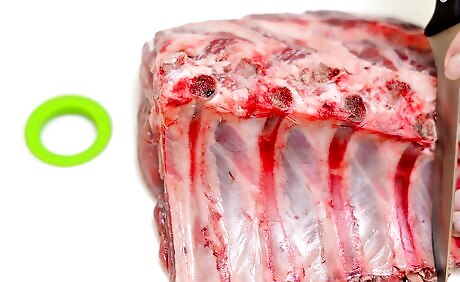
Split the 4th quarter into 2 parts. Find the space between the 4th and 5th ribs. Make a cut between these ribs and discard ribs 1 through 4. Then, you are left with ribs 5 through 12. This step ensures that you are left with the ribs that are most viable for spareribs.
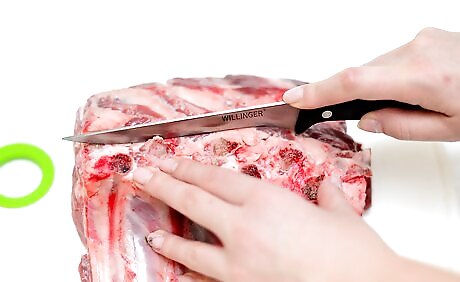
Cut away the ribeye steaks from the rib cage. This piece of meat is located at the top of the ribcage. Find the side of the rib cage where you can clearly see the "eye" of the ribeye. The eye will look like an oval piece of meat surrounded by a small layer of fat. Using this as a marker, make a cut perpendicular to the ribs and through the entire rib cage.
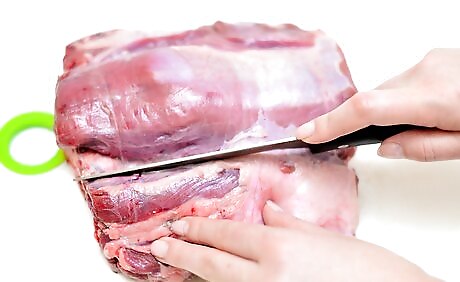
Remove the navel along the area separated by cartilage. Find the area at the bottom of the ribcage where the ribs end. Locate the cartilage that separates the ribs from the large piece of meat at the bottom and make a cut perpendicular to the rib bones along the cartilage line.
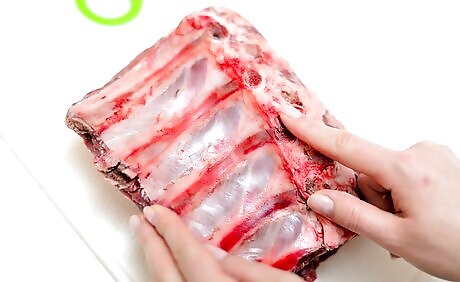
Cut ribs 5 through 12 into 4 in (10 cm) strips. Measure 4 in (10 cm) down from the top of the ribs and make a cut through all of the ribs perpendicular to the bones. Repeat this until all ribs have been cut into 4 in (10 cm) sections. {convert|4|in|cm|abbr=on}} strips are the traditional measurement for the length of spare ribs. However, you can also cut them into 3 in (7.6 cm) strips or smaller depending on your preference.
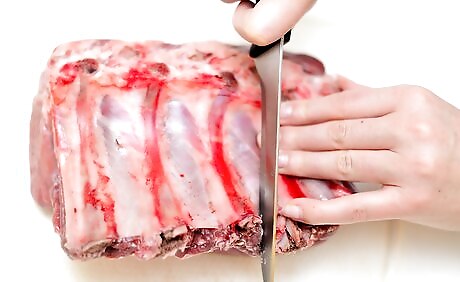
Split ribs 9 through 12 away from 5 through 8. Use your knife to make a complete cut between ribs 8 and 9. Make sure to not cut too close to the rib and to leave some muscle on either end of the cut. These ribs contain too much fat to be used for short ribs. However, you may choose to save these ribs for sausage or ground beef.
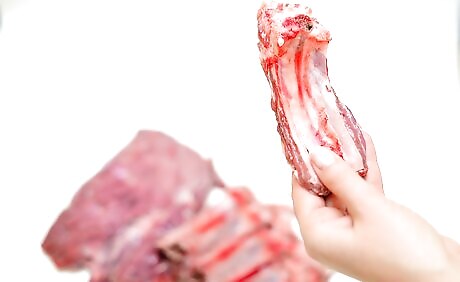
Using ribs 5 through 8, cut between each bone. Leave meat on both sides of the bone, making sure you do not cut too close to the rib. This is called English cut short ribs. For flanken cut short ribs, instead of cutting between the bones, make 3 in (7.6 cm) cuts perpendicular and through all of the ribs. This leaves each cut of meat with several pieces of bone.

















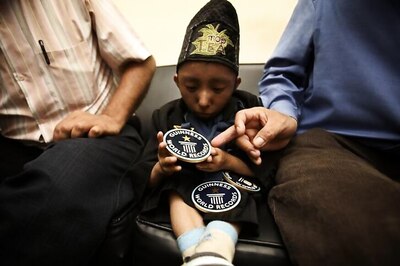

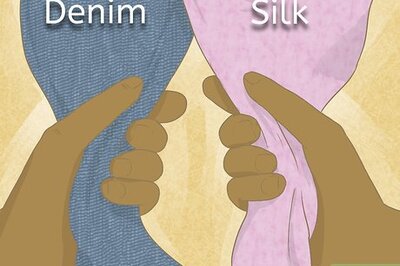
Comments
0 comment